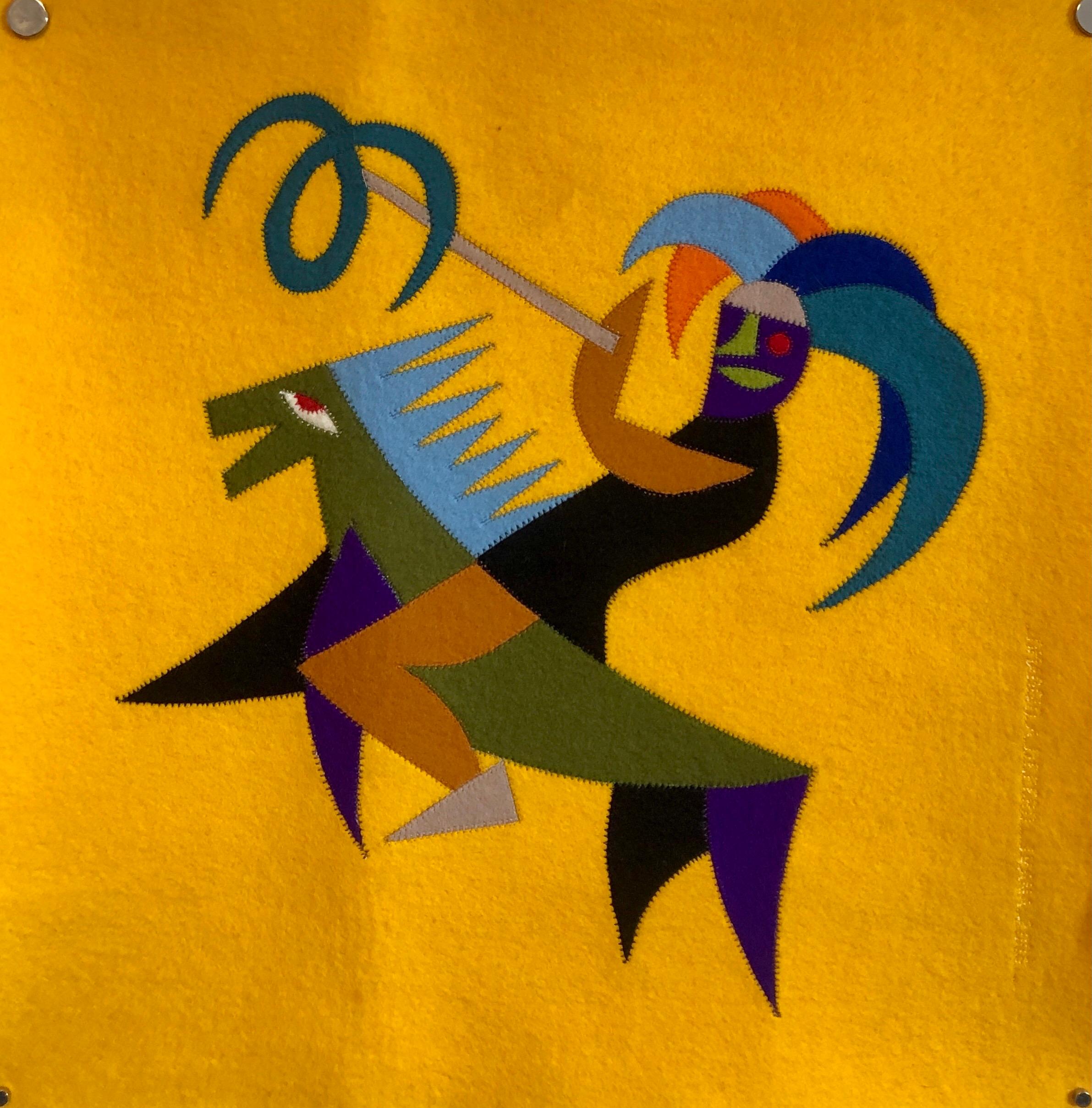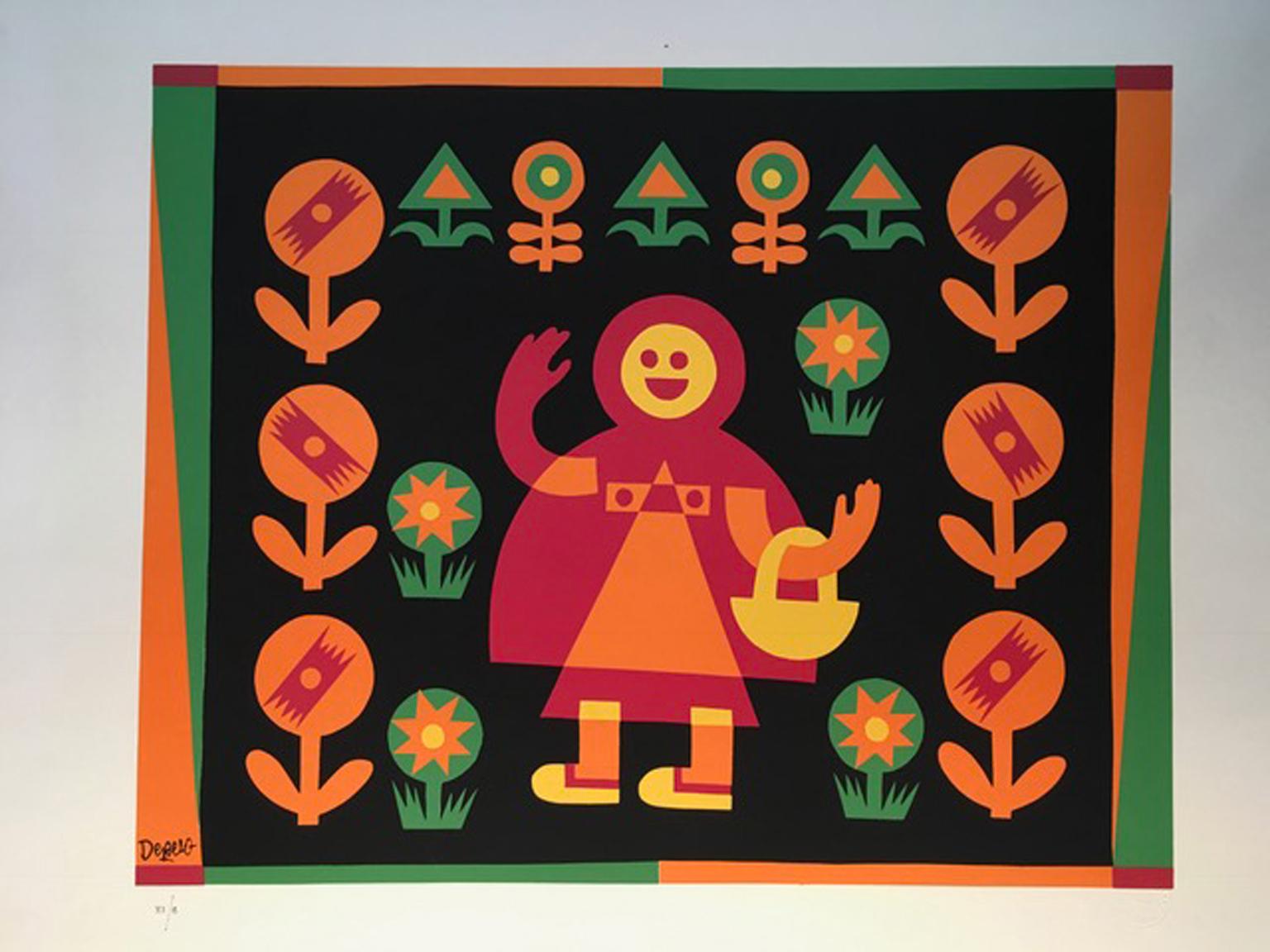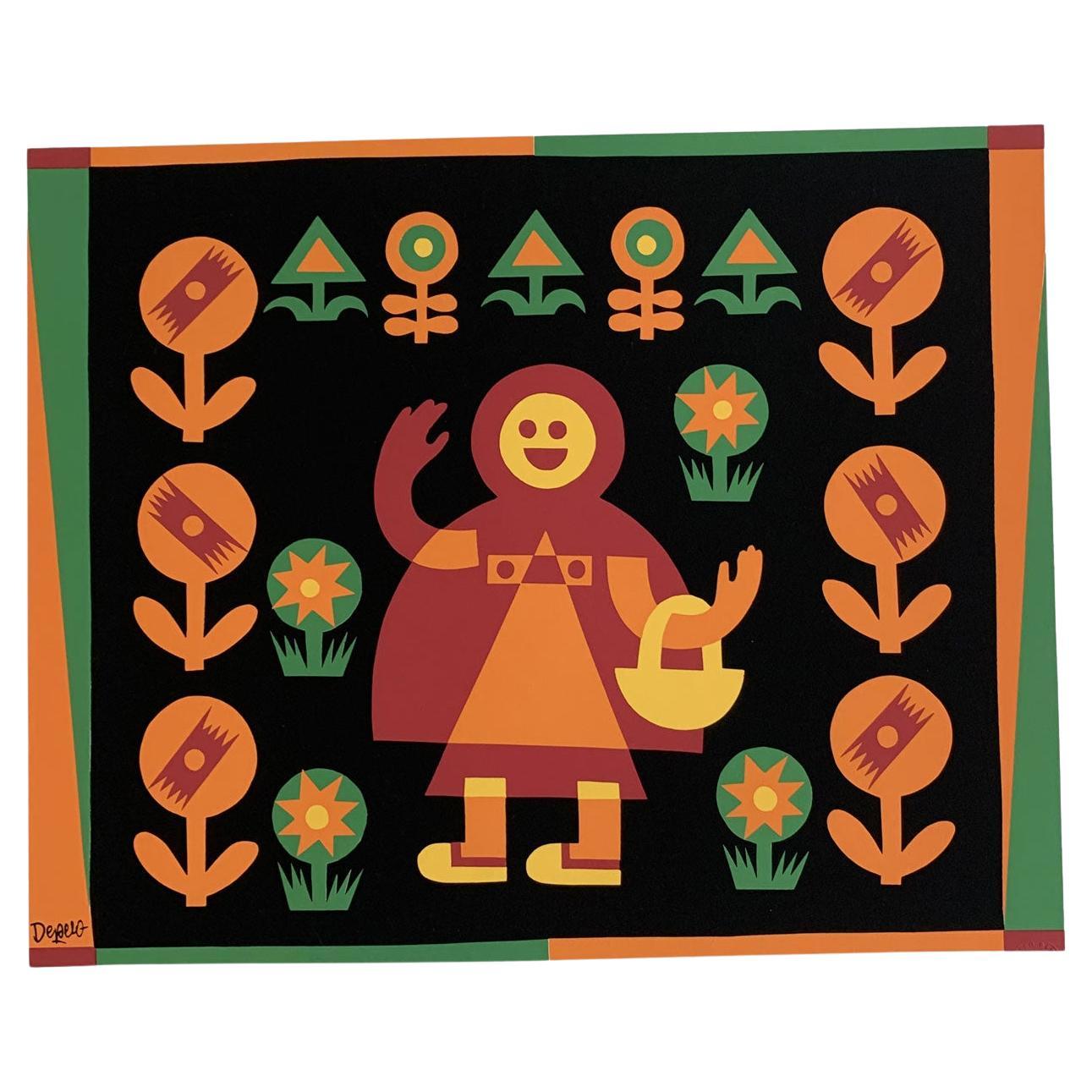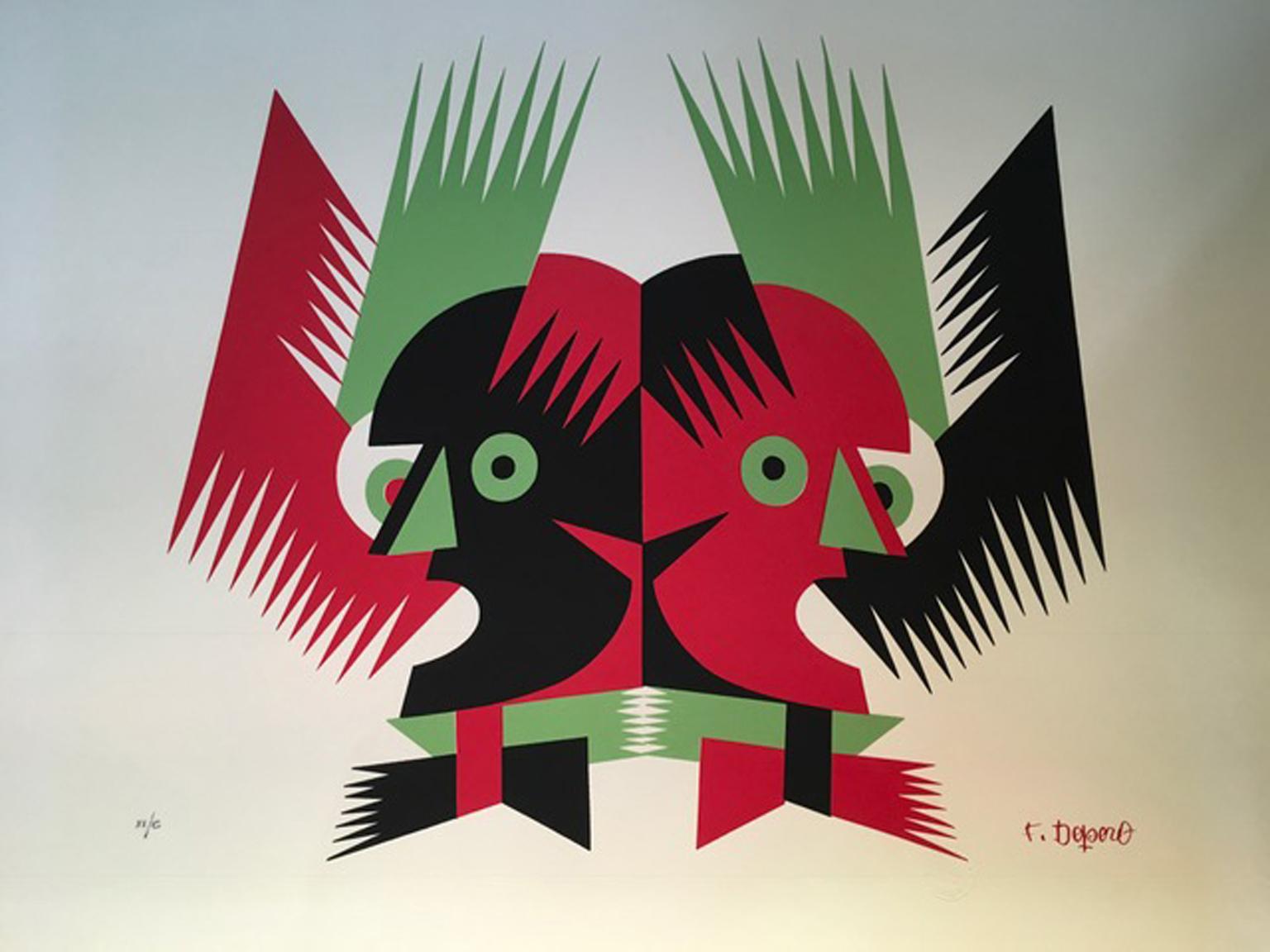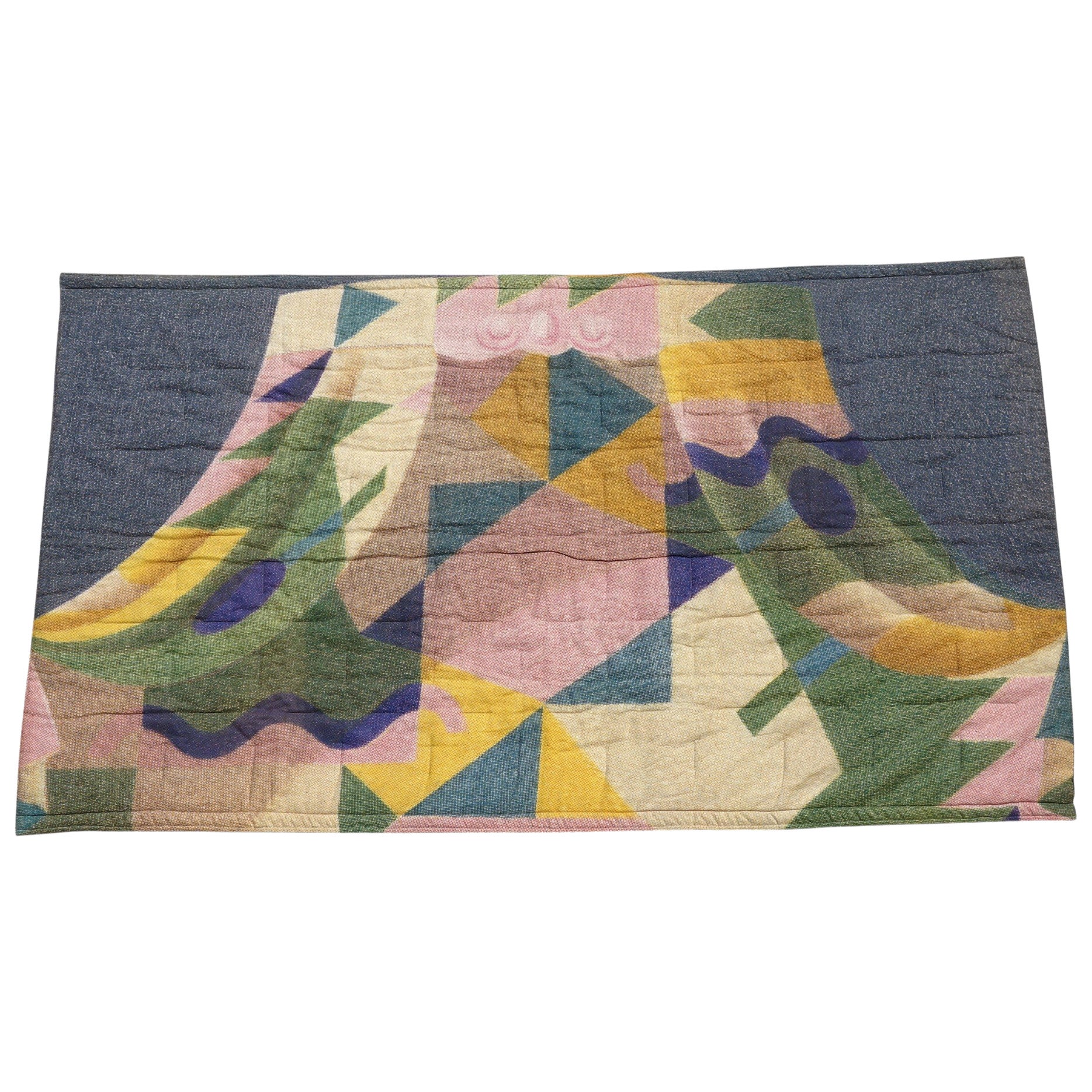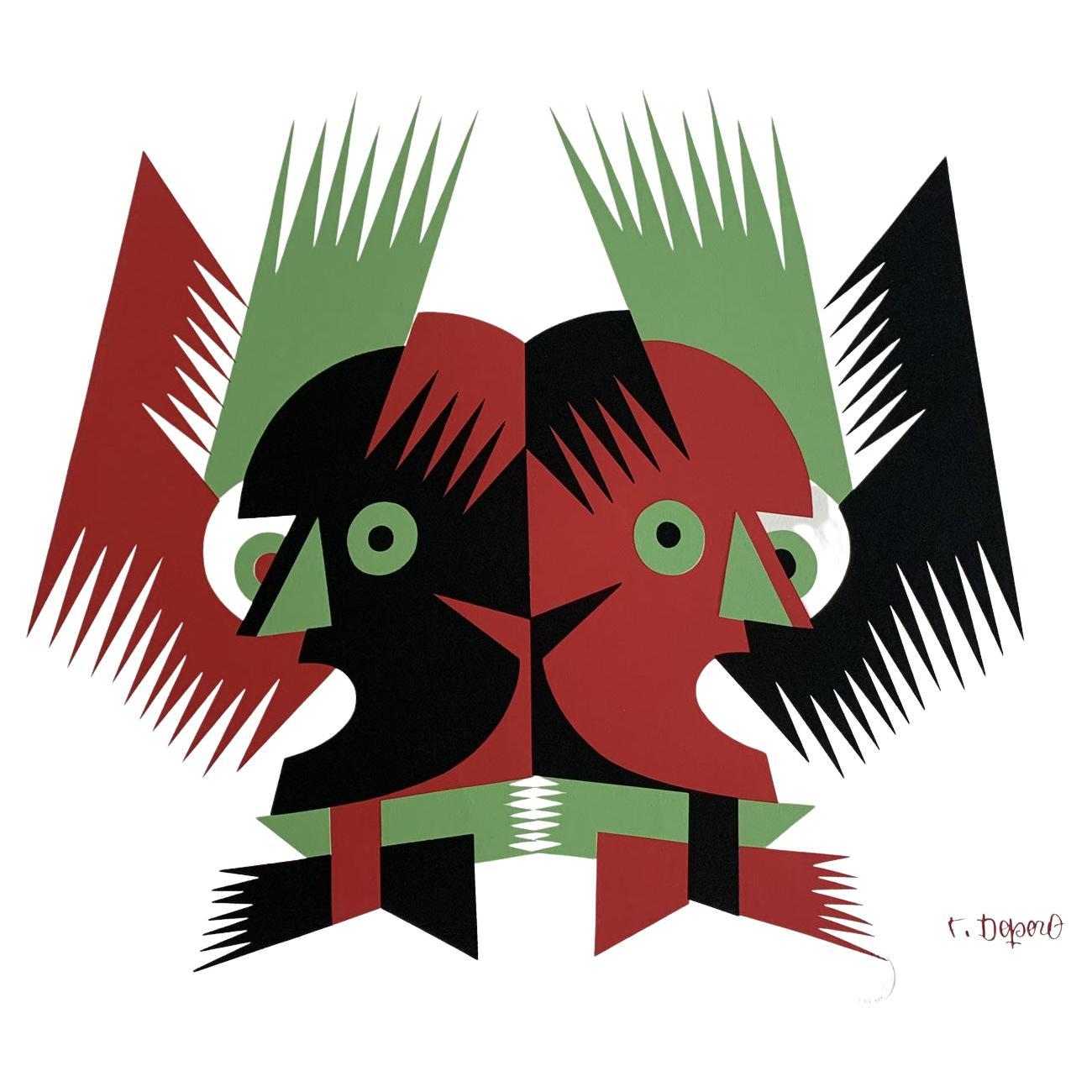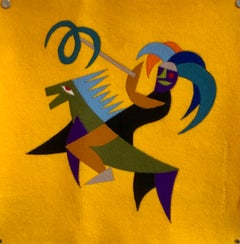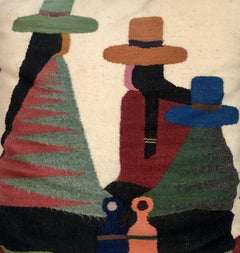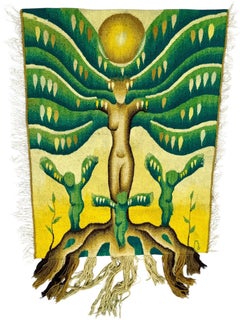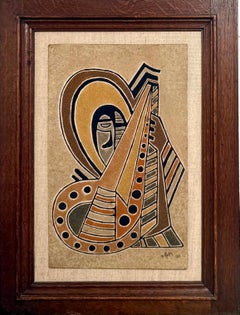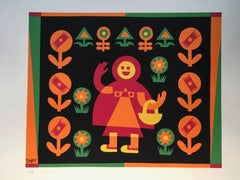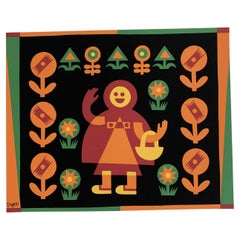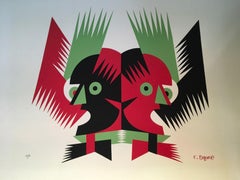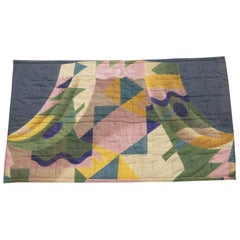Items Similar to Italian Wool Felt Handmade Futurist Fortunato Depero Art Tapestry Wall Hanging
Want more images or videos?
Request additional images or videos from the seller
1 of 9
Ivana GaifasItalian Wool Felt Handmade Futurist Fortunato Depero Art Tapestry Wall Hanging
$1,800
£1,366.88
€1,565.77
CA$2,556.06
A$2,795.94
CHF 1,461.79
MX$33,677.90
NOK 18,270.33
SEK 17,235.49
DKK 11,688.33
About the Item
It is signed in a stitch Omaggio a Depero, Ivana, 2000
Fortunato Depero (1892 – 1960) was an Italian futurist artist and painter, writer, sculptor and graphic designer who worked in a variety of artistic mediums, from painting and graphic poster design (for Bini, Verzocchi, Campari, Strega, Folonari) to furniture and textiles. His work in textiles, created and produced in close collaboration with his wife, Rosetta Amadori, can be considered the most important development in his artistic career, as it comprised a large portion of his creative production. His textiles have been described as embroidery, needlework, tapestry, patchwork, and cloth mosaic – and the persistent relegation of textiles to the realm of crafts, folk art and domestic arts rather than art. He and his wife, Rosetta Amadori, experimented with fabric constructions and realized that their textile creations, which he referred to interchangeably as “cloth mosaics” and “tapestries” (arazzi). Though they are not technically tapestries, the description has remained. Depero grew up in Rovereto, Italy and it was here he first began exhibiting his works, while serving as an apprentice to a marble worker. It was on a 1913 trip to Florence that he discovered a copy of the paper Lacerba and an article by one of the founders of the futurism movement, Filippo Tommaso Marinetti. In 1914 he moved to Rome and met fellow futurist Giacomo Balla. It was with Balla in 1915 that he wrote the manifesto Ricostruzione futurista dell’universo ("Futurist Reconstruction of the Universe") which expanded upon the ideas introduced by the other futurists. In the same year he was designing stage sets for theater and costumes for a ballet. From his hands came paintings, carpets, toys, puppets, advertisements, furniture, clothes, objects, books, posters, costumes, and even a house - his own! - called the House of the Magician. In 1919 Depero founded the House of Futurist Art in Rovereto, which specialised in producing toys, tapestries and furniture in the futurist style. In 1925 he represented the futurists at the Exposition Internationale des Arts Décoratifs et Industriels Modernes (International Exposition of Modern Industrial and Decorative Arts), and presented a Futurist Hall at the Monza Biennial. In 1927 he created for the publisher Dinamo-Azari of Milan one of his most famous objects—the so-called "bolted book" entitled Depero futurista to celebrate the fourteenth anniversary of Futurism. Some of the more prominent Futurists include Umberto Boccioni, Carlo Carrà, Giacomo Balla, and, of course, Fortunato Depero. 1928 saw Depero move to New York City, where he experienced a degree of success, doing costumes for stage productions and designing covers for magazines including MovieMaker, The New Yorker and Vogue, among others. He also dabbled in interior design during his stay, working on two restaurants which were later demolished to make way for the Rockefeller Center. He also did work for the New York Daily News and Macy's, and built a house on 23rd Street. In 1930 he returned to Italy. In the 1930s and 40s Depero continued working, although due to futurism being linked with fascism, the movement started to wane. The artistic development of the movement in this period can mostly be attributed to him and Balla. One of the projects he was involved in during this time was Dinamo magazine, which he founded and directed. After the end of the Second World War, Depero had trouble with authorities in Europe and in 1947 decided to try New York again. One of his achievements on his second stay in the United States was the publication of So I Think, So I Paint, a translation of his autobiography initially released in 1940: Fortunato Depero nelle opere e nella vita (literally, Fortunato Depero, his works and his life). From the winter of 1947 to late October 1949 Depero lived in a cottage in New Milford, Connecticut, relaxing and continuing with his long-standing plans to open a museum. His host was William Hillman, an associate of the then-President, Harry S. Truman.
After New Milford, Depero returned to Rovereto, where he would live out his days. In August 1959 Galleria Museo Depero opened, fulfilling one of his long-term ambitions.
Many of his works are featured in the permanent collection of the Museum of Modern and Contemporary Art of Trento and Rovereto (MART). The Casa d'Arte Futurista Depero, Italy's only museum dedicated to the Futurist movement, containing 3,000 objects, is now one of MART's venues. Closed for many years for extensive refurbishment, the Casa d'Arte Futurista Depero reopened in 2009.
From February 22 until June 28, 2014, the Center for Italian Modern Art, exhibited Depero's work which engaged in dialogues with Dada and Metaphysical Painting, Esprit Nouveau, and Art Deco.
Walter Salin and Giampaolo Campus, interviewed Ivana Gaifas, she was a close friend of Fortunato Depero and his wife Rosetta Amadori in the later part of the artist's life.
They interviewed Carla Amadori (Rosetta Amadori’s niece), Marco Zamboni (Ferruccio Zamboni’s nephew) and Ivana Gaifas (Depero’s couple close friend). Excerpts of these conversations have already been presented in the multimedia show Cava Tapi “La voce dell’antenna” based on Fortunato Depero’s poems and life, which has been performed for the first time in Trento at the Buonconsiglio Castle in 2011. In the conversation with Ivana Gaifas, author of many interpretations in woollen cloth of Depero’s work, still in exhibition in the shop “La casa del Mago” in Rovereto, she describes the place where Depero created his works (Via dei Colli’s house), the planning phase (sketches, division of the space in squares, colours), working ways (by hand), his instruments (the drawing board) and the materials used (fabrics and pannolenci) when he was working on the tapestries.
- Creator:
- Dimensions:Height: 16 in (40.64 cm)Width: 15.5 in (39.37 cm)
- Medium:
- Movement & Style:
- Period:
- Condition:minor wear.
- Gallery Location:Surfside, FL
- Reference Number:1stDibs: LU38215596252
About the Seller
4.9
Platinum Seller
Premium sellers with a 4.7+ rating and 24-hour response times
Established in 1995
1stDibs seller since 2014
1,811 sales on 1stDibs
Typical response time: 1 hour
- ShippingRetrieving quote...Shipping from: Surfside, FL
- Return Policy
Authenticity Guarantee
In the unlikely event there’s an issue with an item’s authenticity, contact us within 1 year for a full refund. DetailsMoney-Back Guarantee
If your item is not as described, is damaged in transit, or does not arrive, contact us within 7 days for a full refund. Details24-Hour Cancellation
You have a 24-hour grace period in which to reconsider your purchase, with no questions asked.Vetted Professional Sellers
Our world-class sellers must adhere to strict standards for service and quality, maintaining the integrity of our listings.Price-Match Guarantee
If you find that a seller listed the same item for a lower price elsewhere, we’ll match it.Trusted Global Delivery
Our best-in-class carrier network provides specialized shipping options worldwide, including custom delivery.More From This Seller
View AllItalian Wool Felt Handmade Futurist Fortunato Depero Art Tapestry Wall Hanging
By Ivana Gaifas
Located in Surfside, FL
It is signed in a stitch Omaggio a Depero, Ivana, 2000
Fortunato Depero (1892 – 1960) was an Italian futurist artist and painter, writer, sculptor and graphic designer who worked in...
Category
20th Century Futurist More Art
Materials
Wool, Felt, Thread
Vintage Handwoven Tapestry Wool Folk Art Rug Weaving Pillow or Wall Hanging
By Olga Fisch
Located in Surfside, FL
Olga Fisch was born in Hungary, studied in Germany and lived in Morocco and Ethiopia before receiving asylum as a Jewish refugee in Ecuador in 1939. For her Indian-inspired designs, Mrs. Fisch uses natural black and white sheep...
Category
1950s Folk Art More Art
Materials
Wool
Hand Woven Wool Tapestry Feminist Textile Art Wall Hanging Judy Chicago Homage
Located in Surfside, FL
This measures 41 inches in width and 75 inches in height to end of tassels without the tassels it is 57 inches in length
This is a wool handmade weaving tapestry, The imagery seems i...
Category
1970s Feminist Mixed Media
Materials
Wool
1952 Hungarian Cubism Wall Hanging Relief Sculpture Sand Painting Cubist A. Reth
By Alfred Reth
Located in Surfside, FL
Alfred Reth (1884-1966)
Mixed media composition on panel
Gritty, sand like texture
Hand signed and dated 1952 in lower right corner
Frame: H 26.5 in X W 20.5 in. Panel: H 19 in. W 12...
Category
1950s Cubist Abstract Sculptures
Materials
Mixed Media, Board
70's Large Colorful Abstract Expressionist Art Protis Tapestry Wool Wall Hanging
By Robert Freimark
Located in Surfside, FL
Art Protis Wall Tapestry
Robert Freimark (1922 - 2010)
Bob Freimark was active/lived in Ohio, California, Michigan. Robert Freimark is known for abstract expressionist painting, ...
Category
1970s Abstract Expressionist Mixed Media
Materials
Wool
Wool Felt Applique Israeli Folk Art Signed Tapestry Kopel Gurwin Bezalel School
By Kopel Gurwin
Located in Surfside, FL
This depicts KIng David reciting Psalms, Hallelujah in Hebrew
Kopel Gurwin (Hebrew: קופל גורבין) (1923–1990) was an Israeli tapestry wall hanging, painter and graphic artist.
Kopel (Kopke') Gurwin (Gurwitz) was born and raised in Vilna, the capital of Lithuania. He spoke Yiddish at home, but simultaneously studied Hebrew at their school which was part of the Tarbut educational network. Kopel was active in the Hashomer Hatzair youth movement. In the 1930s, as a teenager, Kopel helped his parents with the home finances by working in a suit workshop, there he first encountered the art of sewing.
With the outbreak of the Second World War and the German invasion of Vilna, the Jews were imprisoned in camps and ghettos. Kopel and his brother Moshe were separated from their parents and were put to work in coal mines and peat. Kopel's parents were taken to the Stutthof Nazi concentration camp where they died of typhus within a month of each other. Kopel's 12-year-old sister Chava was turned over to the Germans by a Polish family and murdered.
The brothers were arrested by the Germans, but were saved thanks to the connections of Nina Gerstein, Kopel's drama teacher. They hid in an attic until they were discovered, fled and moved to Riga, where they were caught and sent to the Stutthof concentration camp where they were imprisoned until the end of the war. They were put to work maintaining and cleaning trains and took part in one of the death marches. In July 1946, Kopel and Moshe sailed to Helsingborg, Sweden, as part of operation "Folke Bernadotte", in which Sweden took in ill survivors for rehabilitation. Once he recovered, Kopel worked in a publishing house and later was appointed director of the local branch of the Halutz movement.
In 1950 Kopel and Moshe made aliyah to Israel. Kopel worked as a survey for the Survey of Israel Company. In 1951, he enlisted to the Communication Corps and served as a military draftsman. There he won first prize for the design of the front cover of the Communication Corps bulletin.
With his discharge from the army at 29 he started studying drawing and graphics at the Bezalel Academy of Arts and Design in Jerusalem. Among his teachers were Isidor Ascheim, Shlomo Vitkin, Yossi Stern and Jacob Steinhardt. At the end of his first year of study, Kopel won the Reuben and Sarah Lif Excellence Award in written studies. During his studies he also won additional prizes: In 1956 he won first prize from the Lethem Foundation in California for poster design. Later the same year, Kopel won the Hermann Struck prize for his drawing on the theme of Jerusalem.
In 1957 he won an additional first prize from the Lethem Foundation and second place from the printing company Ortzel for a drawing for a Jewish New Year greeting card. In 1958 he won first prize in a competition to design a poster for Tel Aviv's jubilee.
Two years later he won three other awards: First and third prize for designing a poster for Israel Independence Day, celebrating 12 years of the State of Israel.
Also that year Kopel won first prize for a poster to mark the 25th Zionist Congress.
In 1964 he entered the Independence Day poster competition on the theme of aliyah and won first and second prize. Four years later he again entered the competition on the theme of 20 years of Israel's independence and won first prize. The poster was styled like a Holy Ark curtain with two lions and a menorah at its centre. This poster appeared on the cover of the famous book Jewish Art and Civilization, edited by Geoffrey Wigoder as well as the record Voices of 20 Years, 1948-1968, edited by Yossi Godard. In April 1971 he won first prize in the Independence Day poster competition for the fourth time.
Kopel's Folk Art tapestry won the Israeli Independence Day Poster Contest in 1968
With the completion of his studies at Bezalel Kopel moved to Tel Aviv and was hired by Shmuel Grundman's graphics and design studio. Grundman took him to Europe with him to design and supervise the construction of Israeli exhibition pavilions. During his time at Grundman's he discovered the fibrous felt from which he produced most of his wall hangings. At the 1964 Levant Fair exhibition he used felt stuck onto wooden panels for the first time.
The first felt wall hanging that Kopel produced was intended for the American Cultural Centre in Jerusalem and its theme was the United States Declaration of Independence. The wall hanging, which measured 2.85 X 1.85 meters, was stuck on a wooden panel. Kopel ordered rolls of felt from France and began work on wall hangings based on bible stories. He used a needle, hand sewing small even stitches with black embroidery thread which framed and highlighted every detail in the work, as well as using appliqué. The interior designer, Alufa Koljer-Elem, introduced him to Ruth Dayan who managed the shop Maskit in September 1967 he opened his first solo exhibition at the Maskit 6 gallery, in which 12 wall hangings were displayed.
In light of the exhibition at Maskit 6, Meira Gera, the director of artistic activity at the America-Israel Cultural Foundation, organized an additional exhibition of his works at the foundation's exhibition hall in New York City. The exhibition sparked immense press interest, and was also displayed for a few months at the New York Jewish Museum, from where it travelled throughout the United States.
Followed by the exhibition at the Delson-Richter gallery in Old Jaffa, which was later also exhibited at the Jerusalem Theatre.
Kopel's tapestry "The Time for Singing has Arrived" was printed on a UNICEF greeting card in 1978 and again in 1981.
The Israeli Philatelic Service issued three stamps based on three of Kopel's holy ark curtains and one stamp based on an Independence Day poster he designed.
Kopel's creations decorate a large number of synagogues, public buildings, hotels and private collections which were purchased in Israel and around the world. They have decorated, among others, the walls of the King David Hotel in Jerusalem, the VIP room at Ben Gurion Airport, the Kfar Saba theatre and the Plaza Hotel in Tel Aviv.
Israel has had a Vibrant Folk Art, Naive art scene for a long time now artists like Israel Paldi, Nahum Guttman, Reuven Rubin had naive periods. The most well know of the strict naive artists are Shalom of Safed, David Sharir, Irene Awret, Gabriel Cohen, Natan Heber, Michael Falk and Kopel Gurwin.
Exhibitions:
1995 The Knesset Jerusalem
1988 Temple Beth Shalom Miami, Florida
1988 University of Jewish Studies Los Angeles
1987 Israel Congregation on the Northern Coast Chicago
1985 Jerusalem Theatre Jerusalem
1984 Tenafly New Jersey
1983 Horace Richter Gallery Old Jaffa
1974 Jerusalem Theatre Jerusalem
1974 Delson Richter Gallery Old Jaffa
1972 University of Jewish Studies Miami, Florida
1971 Jewish Museum New York
1970 Norman Gallery Canada
1970 Sharei Tzedek Congregation Winnipeg, Canada
1970 Gallery of the Year Los Angeles
1970 Gallery of the Year Scottsdale
1969 Gleeman Gallery Chicago
1969 Israel Congregation of the Northern Coast Chicago
1967 Maskit 6 Tel Aviv
Prizes:
1971 First Independence Day poster 1971, 23 yeaes of the State of Israel
1969 Second International Tel Aviv poster...
Category
20th Century Folk Art Mixed Media
Materials
Wool, Felt
You May Also Like
Italy 1974 Post-Modern Abstract Print Fortunato Depero
By Fortunato Depero
Located in Brescia, IT
This Fortunato Depero wonderful serigraphy is a multiple of 250 printed with the authorization of Museum of Depero in Rovereto (Italy). This is the number XI (eleven)
The title is: L...
Category
1970s Futurist Abstract Prints
Materials
Paper
$2,009 Sale Price
40% Off
Free Shipping
Italy 1974 Post-Modern Depero Multi-Color Print on Paper Numbered Edition
By Fortunato Depero
Located in Brescia, IT
This brigthing Fortunato Depero wonderful print on paper is a multiple of 250 printed by the authorization of Museum of Depero in Rovereto. This is number XI (eleven).
Fortunato Dep...
Category
Late 20th Century Italian Post-Modern Prints
Materials
Paper
$2,009 Sale Price
40% Off
Italy 1974 Post-Modern Abstract Print Fortunato Depero The Twins
By Fortunato Depero
Located in Brescia, IT
This Fortunato Depero wionderful serigraphy is a multiple of 250 specimens printed by the authorization of Museum of Depero in Rovereto (Italy).
This i...
Category
Late 20th Century Futurist Abstract Prints
Materials
Paper
$1,507 Sale Price
40% Off
Free Shipping
1993 Alessandro Mendini Interflex Postmodern Design Wall Hanging Tapestry
By Interflex, Alessandro Mendini
Located in Brescia, IT
"Victorian" Tapestry
designer Alessandro Mendini
prod. Interflex
1993
Screen-printing on quilted Fabric Tapestry
Label manufacture sewing on the back
Perfect Condiction
Limited edi...
Category
1990s Italian Post-Modern Tapestries
Materials
Fabric
Italy 1974 Post-Modern Depero Multi-Color Print on Paper The Twins
By Fortunato Depero
Located in Brescia, IT
This stunning Fortunato Depero print on paper is a multiple of 250 specimens printed by the authorization of Museum of Depero in Rovereto. This is numb...
Category
Late 20th Century Italian Post-Modern Prints
Materials
Paper
$1,507 Sale Price
55% Off
Modern Abstract Tapestry Designed and Handwoven by Steve Chavez
By Steve Chavez
Located in New York, NY
Charming modern tapestry designed and handwoven by Steve Chavez (b. 20th Century, American). Attributed, titled and dated to fabric tag verso: Steve Chavez/ "The Elements"/Ribbon Series/ copyright 1989 S. Chavez/Jan '89
Provenance: "New Mexico Tapestry...
Category
Vintage 1980s American Modern Tapestries
Materials
Tapestry, Wool
More Ways To Browse
Art Deco Vintage New York Poster
Tapestry Wall Hanging
Wool Wall Art
Vintage Wool Wall Hanging
Balla Giacomo
Ballet Costume
Theater Costume
Stage Theater
Stage Set Design
Vintage Macys
Graphic Design Poster
Vintage Ballet Costume
Wool Art Wall Hanging
Vintage Italian Tapestry Tapestries
Filippo Marinetti
Vintage Campari
Italian Futurist Art
Drawing Instruments
